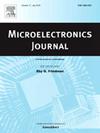A 2-MHz BW 93.2-dB SFDR 2nd-Order Hybrid EF-CIFF Noise Shaping SAR ADC
IF 1.9
3区 工程技术
Q3 ENGINEERING, ELECTRICAL & ELECTRONIC
引用次数: 0
Abstract
This paper presents a 2-MHz BW 93.2-dB SFDR 2nd-order hybrid noise shaping SAR ADC with error-feedback (EF) and cascaded-integrator-feed-forward (CIFF) structure. Compared to a conventional first-order hybrid structure, this work introduces two zeros and two poles, achieving a sharper NTF. These zeros and poles are determined by the capacitance ratio, thereby maintaining great PVT robustness. The proposed NS-SAR ADC employs second-order passive integrators assisted by a unity-gain buffer. This configuration avoids the use of high-performance OTA, reduces design difficulty, and is friendly to process scaling. The prototype 9-bit NS-SAR ADC is fabricated in a 65 nm CMOS technology, measuring a signal-to-noise ratio and distortion ratio (SNDR) of 74.0 dB and a spurious-free dynamic range (SFDR) of 93.2 dB at a sampling rate of 32 MHz. The bandwidth (BW) is 2 MHz under an oversampling ratio (OSR) of 8. The Schreier Figure-of-merit (FoMs) based on SNDR is 170.14 dB.
求助全文
约1分钟内获得全文
求助全文
来源期刊

Microelectronics Journal
工程技术-工程:电子与电气
CiteScore
4.00
自引率
27.30%
发文量
222
审稿时长
43 days
期刊介绍:
Published since 1969, the Microelectronics Journal is an international forum for the dissemination of research and applications of microelectronic systems, circuits, and emerging technologies. Papers published in the Microelectronics Journal have undergone peer review to ensure originality, relevance, and timeliness. The journal thus provides a worldwide, regular, and comprehensive update on microelectronic circuits and systems.
The Microelectronics Journal invites papers describing significant research and applications in all of the areas listed below. Comprehensive review/survey papers covering recent developments will also be considered. The Microelectronics Journal covers circuits and systems. This topic includes but is not limited to: Analog, digital, mixed, and RF circuits and related design methodologies; Logic, architectural, and system level synthesis; Testing, design for testability, built-in self-test; Area, power, and thermal analysis and design; Mixed-domain simulation and design; Embedded systems; Non-von Neumann computing and related technologies and circuits; Design and test of high complexity systems integration; SoC, NoC, SIP, and NIP design and test; 3-D integration design and analysis; Emerging device technologies and circuits, such as FinFETs, SETs, spintronics, SFQ, MTJ, etc.
Application aspects such as signal and image processing including circuits for cryptography, sensors, and actuators including sensor networks, reliability and quality issues, and economic models are also welcome.
 求助内容:
求助内容: 应助结果提醒方式:
应助结果提醒方式:


